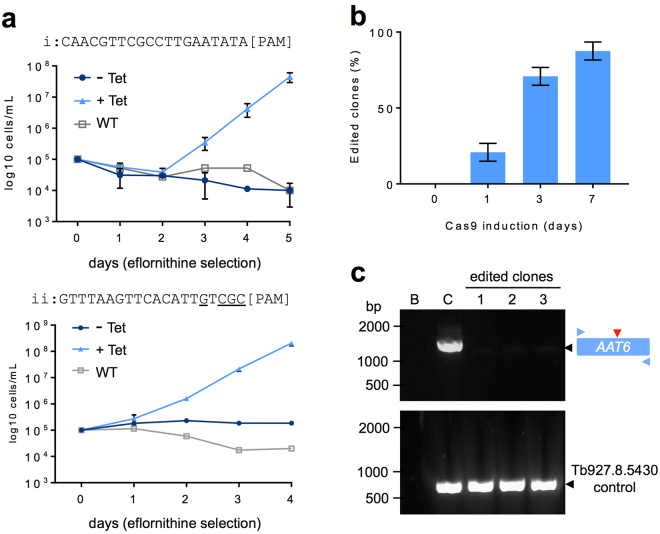Figure 3.
High efficiency Cas9-based editing of the AAT6 gene. (a) Cumulative cell growth in the presence of 270 µM eflornithine (estimated 10 × EC50) following 3-days with (+Tet) or without (−Tet) Cas9 induced editing of AAT6. Two independent Cas9/sgRNAAAT6 clones and wild-type (WT) cells were analysed for each gRNA (i and ii). Error bars, SD. The gRNA sequences are shown above the plot with PAM-adjacent G/C residues underlined (see text for details). As can be seen, eflornithine is a cytostatic rather than cytocidal drug. (b) A cloning assay reveals efficient Cas9 editing by gRNA-ii. Cas9 was induced as indicated followed by sub-cloning in the absence of Tet. The sub-clones were then transferred to medium with or without 270 µM eflornithine and considered ‘edited’ if drug-resistant. Twelve sub-clones were analysed from each of two independent clones (n = 24 sub-clones) for each time-point. (c) The PCR assays reveal AAT6 editing in three independent drug-resistant clones. B, blank – no genomic DNA; C, control – wild-type genomic DNA. The Tb927.8.5430 gene is close to AAT6 and serves as an unedited control. The vertical (red) arrowhead indicates the Cas9 target site. The horizontal (blue) arrowheads indicate the primers used for the AAT6 PCR-assay. Predicted wild-type AAT6 fragment, 1,467 bp; predicted wild-type Tb927.8.5430 fragment, 648 bp.

